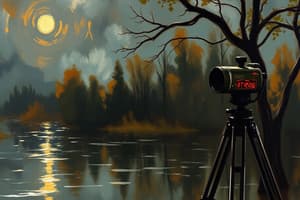Podcast
Questions and Answers
What is the primary function of pressure switches?
What is the primary function of pressure switches?
- To calibrate pressure instruments
- To oppose the bellows force in gauges
- To activate a signal for monitoring and alarms (correct)
- To measure temperature changes
During the dead weight calibration process, what is the role of the calibrated weights?
During the dead weight calibration process, what is the role of the calibrated weights?
- To calculate the area of the piston
- To float the measuring piston (correct)
- To measure temperature accurately
- To apply force on the fluid directly
Which pressure measurement device uses a spring to limit the bellows expansion?
Which pressure measurement device uses a spring to limit the bellows expansion?
- Bourdon Tube Manometer
- U-Tube Manometer
- Helical Bourdon Pressure Instrument
- Simple Bellows Gauge (correct)
What formula is used to calculate the pressure in the dead weight calibration method?
What formula is used to calculate the pressure in the dead weight calibration method?
What type of switch is commonly used for high or low-pressure applications?
What type of switch is commonly used for high or low-pressure applications?
What is a key requirement for the sensor to accurately measure a substance's level?
What is a key requirement for the sensor to accurately measure a substance's level?
Which factors can affect the accuracy and repeatability of ultrasonic measurements?
Which factors can affect the accuracy and repeatability of ultrasonic measurements?
In what scenario is a radar sensor particularly advantageous over an ultrasonic sensor?
In what scenario is a radar sensor particularly advantageous over an ultrasonic sensor?
How do radar level sensors generate signals for measurement?
How do radar level sensors generate signals for measurement?
What is one common application for ultrasonic sensors mentioned in the content?
What is one common application for ultrasonic sensors mentioned in the content?
Flashcards are hidden until you start studying
Study Notes
Sensor Technology
- Sensors can measure levels of substances without physical contact, requiring only a clear view of the surface.
- Common applications include corrosive liquids, slurries, grease, waste, grain silos, and cement containers.
- Ultrasonic sensors utilize frequency signals that reflect off material surfaces; distance is calculated from travel time of the signal.
- Accuracy can be affected by humidity and temperature variations, necessitating compensation methods in levels measuring systems.
Radar Level Sensors
- Radar sensors extend ultrasonic capabilities for non-contact measurements, particularly in challenging environments like vapor, dust, or foam.
- They employ microwave pulses, ensuring reliability regardless of environmental conditions.
Pressure Instruments
- Pressure switches are widely used for high/low pressure detection; they activate signals for monitoring and alarm systems.
- Modern devices often utilize electronic switches to improve functionality.
Calibration of Pressure Instruments
- Calibration is traditionally performed using dead weight calibration, which involves:
- Loading a piston with calibrated weights and adjusting until it appears to float on fluid.
- Calculating pressure using the relation: P = Force (weights) / Area (piston).
Temperature Measurement
- Temperature is defined as the heat or cold exhibited by a substance and is quantified as thermal energy per molecule.
- Temperature scales are based on points of thermal equilibrium, with the Celsius scale referenced at points where water exists simultaneously as solid, liquid, and gas.
Temperature Sensor Types
- Floats: Measure liquid levels directly; use floating balls or cylinders connected to linked switches.
- Pneumatic Sensors: Suitable for hazardous areas and power-free environments, compressing air against a diaphragm to signal levels.
- Conductivity Probes: Utilize low voltages for measurement, classifying them as “Intrinsically Safe” since they can't ignite.
Flow Measurement
- Flow is quantified by rate (amount moving past a point per unit time) and total flow (amount passing a point over a period).
- Differential Pressure Flow Meters: Measure flow based on pressure drop, proportional to the square of the flow rate; consist of primary elements (creating pressure differential) and secondary elements (measuring the differential).
Studying That Suits You
Use AI to generate personalized quizzes and flashcards to suit your learning preferences.




